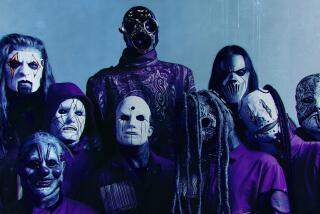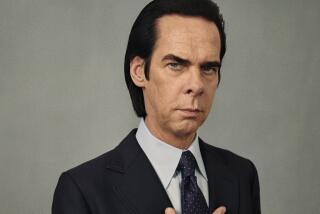Rock Can’t Shake Its Devilish Reputation
- Share via
They’re ba-ack.
Halloween is here, and those creatures born of humanity’s darkest nightmares are rearing their horrific heads once again.
I’m not talking about werewolves, vampires or home mortgage insurance salesmen. It’s the Rock-Music Bashers that scare me.
They’ve been popping up all over the place recently:
-- In a two-hour TV special last week when Geraldo Rivera examined the evils of Satanism (isn’t that redundant?).
-- In an ongoing lawsuit against Judas Priest, a heavy metal band whose music is being blamed for the suicide of a teen-ager.
-- In a recent two-part series in this newspaper about three Missouri teen-agers who bludgeoned one of their friends to death.
In each case, prominence has been given to the crime-inducing role that rock--specifically heavy metal music--allegedly has had.
After an interview with the mother of a teen-ager who has been sentenced to life without parole for the fatal baseball-bat beating of a classmate last year, Geraldo used this tag-line:
“Another example of the link between heavy metal music and crime . “
In a recent study into connections between heavy metal music and drug abuse, one 16-year-old summarized every parent’s nightmare when he said:
“Satan, drugs and heavy metal were my life.”
Indisputably, heavy metal music has been a central focus in the lives of some teen-agers, as has serious drug abuse and, in certain cases, satanic religious practices.
A Tennessee study by psychiatrist Paul King said that “59.1% of patients admitted primarily for chemical dependency made heavy metal their first choice of music.”
But it’s equally true that most teen-agers who get in trouble wear blue jeans, drive cars or eat hamburgers. Rock music--even heavy metal--no more causes teen-agers to become devil-worshiping murderers than marching band music causes football games.
If that was the case, high school band rooms everywhere would overflow with pigskins and quarterbacks and America would be overrun with millions of zombie-fied killers who bought the last Iron Maiden album.
A story in The Times about the grisly killing in Missouri said that ringleader Jim Hardy “had been an altar boy and honor student before his grades and behavior took a sudden tumble when he was 11.”
“The nuns at his parish school suggested professional help, and Jim had sulked through a few sessions at the Ozark Mental Health Center in Joplin before his exasperated parents gave up. Nancy and James Hardy had been going through a separation and assumed the family turmoil had triggered Jim’s outbursts. . . . Jim Hardy was a drug-abuser and a sadist. He had been popping pills since the sixth grade. He had been mutilating animals for even longer.”
Sounds to me like the kid had more going against him than bad taste in music.
Fortunately, some experts, such as King, draw the distinction between a type of music associated with a life style and the causes of that life style. Another is Lorraine Prinsky, a Cal State Fullerton sociology professor who conducted a widely disseminated study in 1987 that indicated the vast majority of teen-agers don’t pay much attention to rock lyrics.
Prinsky, who is scheduled to serve as an expert witness on rock lyrics at the Judas Priest trial in Reno, said music frequently is used as a scapegoat. “Whenever I read about these cases . . . I always wonder: Where are the parents?
“The mother of the (Missouri murder) victim said she knew he was going to be killed. She kept him away from other kids but never told him of her concerns. She just manipulated him so he wouldn’t be with other kids, kept him home. She never confronted the issue. . . . It’s a matter of being in touch with your kids, talking to them and asking about it.”
In any case, why are we hearing so much about this now? Is occultism and radical teen-age delinquency becoming epidemic?
Prinsky thinks not. “I think it makes a good Halloween story. . . . The timing is good.”
YO! CULTURE FREAKS--At last, a plea for money I can relate to. Instead of touting how culture (like yogurt) is good for all of us, or how much (like Riboflavin) it enriches us as individuals or generally makes the world a better place, the new music director of the Orange Coast College Symphony goes straight to the point.
He opens his fund-raising mailer like this:
“Dear Friend of OCC: HELP!!”
Anyone who has been deluged with politely worded, tastefully crafted brochures and flyers lately ought to send these folks a ten-spot just for having the chutzpah to show a sense of humor.
After the large, hand-scrawled “HELP!!,” director Alan Remington writes: “I’m using this subtle, soft-sell approach because many of you rock ‘n’ roll fans have had limited exposure to culture and must be nursed along slowly. . . .”
How much does this group need our donations? “Although difficult to verify, there are probably 13 back-country provinces in India with more working capital than our symphony. (You may at this point want to send your money to India and forget the OCC Symphony.)”
Before signing off, Remington reminds the historically impaired that “our programs are held in Costa Mesa’s first major performing arts center--the Robert B. Moore Theatre.” (I guess that means Dick’s Horseshoe Saloon doesn’t count, huh?)
Then, the reader has a choice. First is “YES--I am masochistically inclined and will donate my hard-earned life savings to OCC’s Symphony Orchestra. Enclosed is my donation: --$20 for 1 season pass, --$40 for 2 season passes, --$100 for 5 season passes, --$10,000 for a performance in your home.”
On the other hand, the reader can check “NO--I am a confirmed rock ‘n’ roller and would rather put my money into something useful--like earplugs. Please send me my heavy metal plugs. Enclosed is my check: --$10 (1 pair), --$20 (2 pair), $25 (2 pair + nose ring), --$10,000 (for a 20-year subscription to “Easy Rider” magazine).
Mr. Remington, with a letter like that, how can I refuse? My check’s in the mail.
More to Read
The biggest entertainment stories
Get our big stories about Hollywood, film, television, music, arts, culture and more right in your inbox as soon as they publish.
You may occasionally receive promotional content from the Los Angeles Times.










